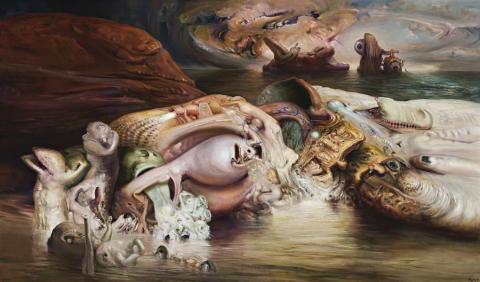REEF, 1983
JAMES GLEESON
oil on linen
101.5 x 172.5 cm
signed and dated lower right: Gleeson'83
signed, dated and inscribed verso: “REEF” 24.8.83 James Gleeson
Private collection, Sydney, acquired directly from the artist in 2006
James Gleeson Recent Paintings, Watters Gallery, Sydney, 7–24 November 1984, cat. 1
James Gleeson Recent Paintings, Pinacotheca Gallery, Melbourne, 9–26 April 1986, cat. 1
A Close Focus on an Extraordinary Vision, Maitland Regional Art Gallery, New South Wales, 23 March – 3 June 2012, p. 26 (label attached verso)
Klepac, L., James Gleeson: Landscape out of Nature, Beagle Press, Sydney, 1987, fig. 73–74, pp. 103–104 (illus.)
Klepac, L., James Gleeson: Beyond the Screen of Sight, Beagle Press, Sydney, 2004, fig. 18, p. 196 (illus.)
Klepac, L., Peregian Codex: James Gleeson, Beagle Press, Sydney, 2008, p. 19 (illus.)
Klepac, L., James Gleeson: Agapitos/Wilson Annual, Maitland Regional Art Gallery, New South Wales, 2012, p. 26 (illus.)
This work is accompanied by a deluxe edition copy of Klepac, L., Peregian Codex: James Gleeson, Beagle Press, Sydney, 2008, edition 90/100, signed by James Gleeson and includes a signed etching by James Gleeson titled, Storm Rods, 2007
Reef, 1983 is a seminal work in James Gleeson's oeuvre. At the end of 1982, having recently completed his monograph on Robert Klippel, Gleeson decided to retire from his public life as an art critic, which had restricted his own artistic output for many years, with the aim to begin a clear, new stage in his own artistic career and devote himself to an ambitious new series of major works. Gleeson and his partner Frank O'Keefe took their annual holiday to Peregian in Queensland where a great turning point occurred in the form of a body of work now called the Peregian Codex. This series of 22 collages created between December 1982 and January 1983, formed the basis of the new direction of spectacular large scale works.
As curator and historian Lou Klepac explains,'The late works are amazing but their number is even more staggering. From August 1983 to June 2007 Gleeson completed 474 large paintings. As the first of the great series of works which he began to produce after his 68th birthday, No.1 Reef has a special connection to Peregian because it was inspired by the rock pools which had always fascinated Gleeson. It was based on a drawing dated 28.12.82 made at Peregian. Renee Free, who produced a detailed catalogue raisonne of Gleeson's paintings to 1990, recorded the artist's comment on this particular work:
'That takes me right back to my earliest memories as a child. We lived in North Gosford at that time - about seven miles to the coast at Terrigal. We used to go on Sunday picnics in a sulky and buggy out to Terrigal and it fascinated me because of the rocks that were jutting out into the sea there, filled with pools and in those pools I discovered marvellous things. It really awakened my interest in that whole coastal area. The shapes and colours were fantastic. I used to spend hours just peering into these small rock pools around the base of the Skillion and along that coast near Terrigal.
Later on I went to other places where there were rocky forms and these magical pools with their treasures of shapes and colours and (to me) unidentifiable objects. It was from these earlier experiences that I've developed this really quite deep interest in that intertidal area of the coast. It has stayed with me. When we go north to Queensland, we do the same thing.
Reef, the first of this series, began out of that fascination with forms based on the coast. I didn't start with that in mind but find it had that treasure of shape, colour and form that I did find on that coast, so I called the picture Reef - suggesting a reef exposed at low tide with all its gleaming treasures to be seen. I had no real first-hand experience of the actual Barrier Reef. The only time we went there we went to Great Keppel Island, the tip of the Reef, off Rockhampton. That wasn't really the reef. I don't know if there is a Jungian undercurrent - that we did as a species come from the sea. Perhaps that is reading things into it that aren't there. But this fascination with that area was in that picture and it has cropped up in a large number of paintings since then.'
The execution of Reef was a momentous step and Gleeson kept the painting for many years; in latter years it hung over his bed. It was only when a passionate collector of his work became particularly interested in it, that the painting finally left the artist's home.'1
1. Klepac, L., Peregian Codex: James Gleeson, Beagle Press, Sydney, 2008, pp. 18-23 (illus. p. 19)
